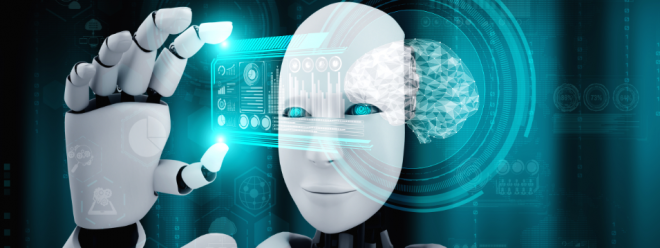Key trends in robotics in 2024

1. Artificial Intelligence (AI) and Machine Learning
There is a growing trend to use artificial intelligence in robotics and automation. The emergence of generative artificial intelligence opens up new solutions. This subset of artificial intelligence specializes in creating new things from what is learned through training, and has been popularized by tools such as ChatGPT. Robot makers are developing generative AI-driven interfaces that allow users to program robots more intuitively using natural language rather than code. Workers will no longer need specialized programming skills to select and adjust robot movements.
Another example is predictive AI analyzing robot performance data to determine the future state of equipment. Predictive maintenance can save manufacturers the cost of machine downtime. The Information Technology and Innovation Foundation reports that in the auto parts industry, unplanned downtime costs an estimated $1.3 million per hour. This shows that predictive maintenance has huge cost-saving potential. Machine learning algorithms can also analyze data from multiple robots performing the same process for optimization. Generally, the more data a machine learning algorithm is given, the better it performs.
2. Collaborative robots expand new applications
Human-machine collaboration remains a major trend in the field of robotics. Rapid advances in sensors, vision technology and smart grippers allow robots to respond to environmental changes in real time to work safely alongside human workers.
Collaborative robot applications provide human workers with a new tool that eases their burden and supports them. They can assist with tasks that require heavy lifting, repetitive movements, or working in hazardous environments. The range of collaborative applications offered by robot manufacturers continues to expand.
A recent market development is the increase in collaborative robot welding applications, driven by a shortage of skilled welders. This demand suggests that rather than causing labor shortages, automation provides a way to address the problem. Collaborative robots will therefore complement rather than replace investments in traditional industrial robots, which can operate much faster and thus remain important for improving productivity in the face of tight product margins.
New competitors are also entering the market, focusing on collaborative robots. Mobile manipulators, a combination of collaborative robotic arms and mobile robots (AMRs), offer new use cases that may significantly expand the demand for collaborative robots.
3. Mobile manipulator
对于第三个趋势,IFR指出,移动机械手(即所谓的“MoMas”)正在使汽车、物流或航空航天等行业的物料搬运任务自动化。它们将机器人平台的移动性与机械臂的灵活性相结合。这使它们能够在复杂的环境中导航并操纵物体,这对于制造业的应用至关重要。这些机器人配备传感器和摄像头,可对机器和设备进行检查和维护任务。移动机械手的显著优势之一是它们能够与人类工人协作并为其提供支持。熟练劳动力的短缺和工厂岗位的应聘人员不足可能会增加需求。
4.Digital twin
Digital twin technology is increasingly used as a tool to optimize the performance of physical systems by creating virtual copies. As robots are increasingly digitally integrated into factories, digital twins can use data from their real-world operations to run simulations and predict possible outcomes. Because the twin exists purely as a computer model, it can be stress tested and modified without any safety hazards and cost savings. All experiments can be checked before exposure to the physical world. Digital twins bridge the gap between the digital and physical worlds.
5. Humanoid robot
We are seeing significant advances in humanoid robots designed to perform a variety of tasks in a variety of environments. The humanoid design with two arms and two legs allows the robot to be used flexibly in work environments designed for humans. Therefore, it can be easily integrated into existing warehouse processes and infrastructure.
The Ministry of Industry and Information Technology predicts that humanoid robots are likely to become another disruptive technology, similar to computers or smartphones, that will completely change the way we produce goods and the way humans live.
The potential impact of humanoid robots on various industries makes them an exciting area of development, but their large-scale market adoption remains a complex challenge. Cost is a key factor and success will depend on their ROI to compete with established robotic solutions such as mobile manipulators.